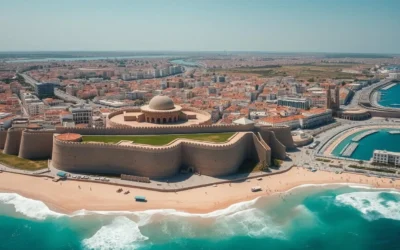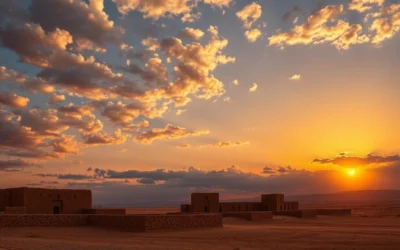✓ Accommodations✓ Flights✓ Rental Cars✓ Tours & Activities ✓ Tours & Activities
Planning a trip to Tunisia can be a thrilling experience, with its stunning beaches, ancient ruins, and vibrant markets. To make the most of your journey, timing is everything. You need to consider the best time to visit this North African gem.
The country’s diverse climate patterns mean that the season can significantly impact your travel experiences. Whether you’re looking to bask in the sun or explore cultural treasures, understanding the weather conditions is crucial. Visiting during the spring or autumn season can provide a blissful experience, with mild temperatures perfect for exploring the bustling medinas and ancient ruins.
By choosing the right time for your trip, you can enjoy Tunisia’s Mediterranean coast, desert landscapes, and rich historical sites to the fullest. This guide will help you identify the optimal time to travel to Tunisia based on your preferences.
Understanding Tunisia’s Climate and Seasons
Understanding the climate and seasons in Tunisia is crucial for planning your trip. Tunisia’s geography creates a diverse range of climates across its relatively small territory.
Mediterranean Climate Patterns
Tunisia’s climate is characterized by Mediterranean patterns, with the coastal regions enjoying more moderate temperatures thanks to the Mediterranean Sea breezes. The northern coastal areas, such as Tunis and Carthage, experience milder weather year-round.
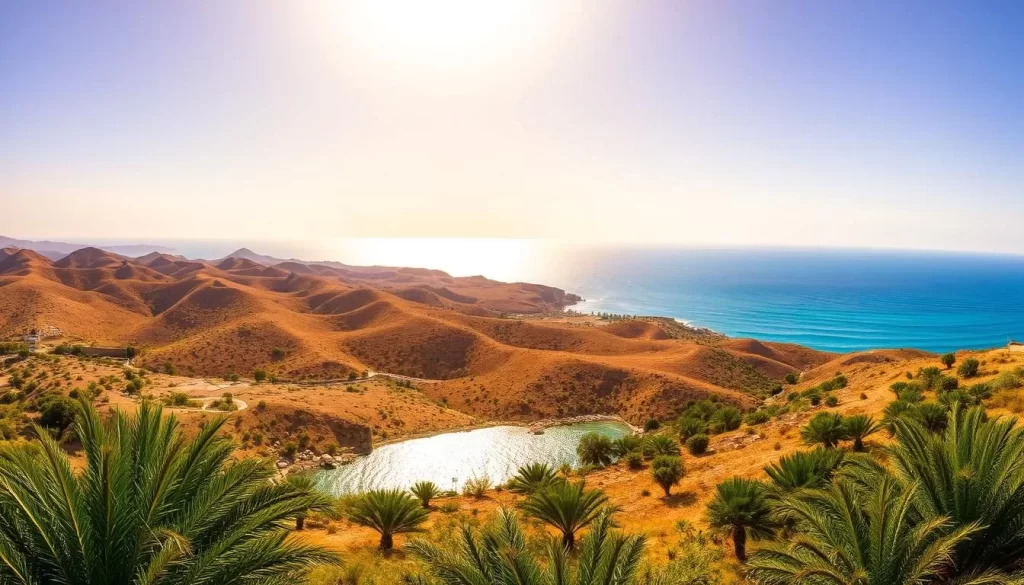
Regional Weather Variations
The country’s diverse geography results in distinct microclimates across different regions. Central Tunisia faces greater temperature fluctuations, while the southern desert regions experience extreme heat during the day and can be surprisingly cold at night, especially in seasons like winter.
| Region | Climate Characteristics | Seasonal Variations |
|---|---|---|
| Northern Coastal | Mild temperatures, moderate climate | Less extreme heat in summer, mild winters |
| Central Tunisia | Greater temperature fluctuations | Hotter summers, cooler winters |
| Southern Desert | Extreme heat, minimal rainfall | Very hot days, cold nights in winter |
As you plan your visit, understanding these climate variations will help you choose the best season for your travel preferences.
Peak Season: April to June
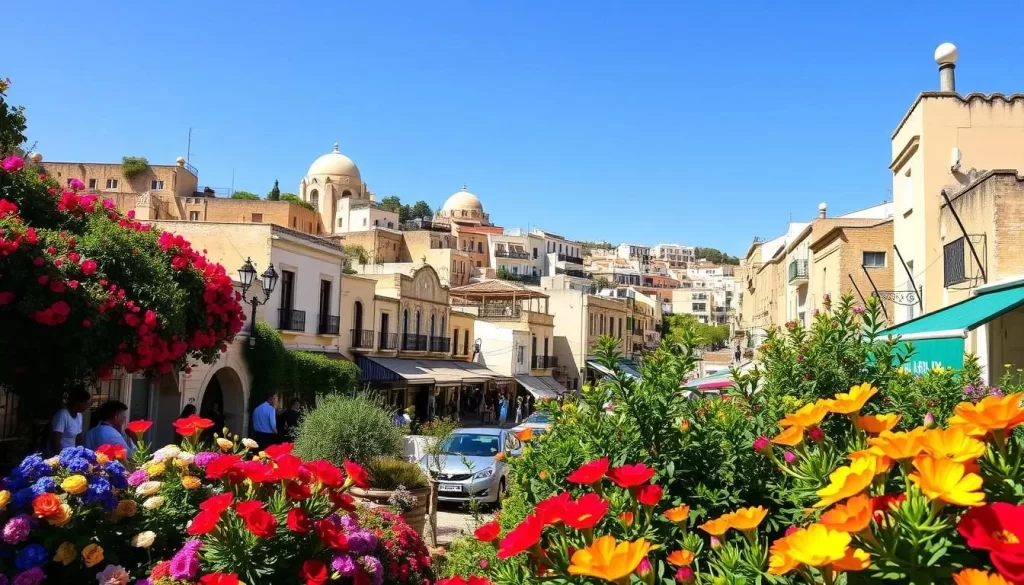
As spring unfolds, Tunisia transforms into a vibrant destination, making April to June an ideal time to visit. You can expect a peak tourist season that brings numerous benefits and a few considerations to keep in mind.
Perfect Weather Conditions
The weather during April to June is characterized by mild temperatures and minimal rainfall, creating perfect conditions for exploring Tunisia’s rich history and culture. You can enjoy the pleasant climate, making it an ideal time for outdoor activities.
Popular Attractions and Activities
During this period, you can experience Tunisia’s diverse attractions, from historical sites to beautiful beaches. Tourists flock to popular destinations like Sidi Bou Said and Hammamet, enjoying the local cuisine and cultural events.
What to Expect: Crowds and Costs
As the peak tourist season progresses, you should be prepared for a few changes. Here are some key points to consider:
– April to June sees a steady increase in tourist numbers, with European visitors particularly prevalent.
– Hotel rates begin to rise, especially in popular coastal resorts and boutique accommodations in historic medinas.
– Despite the increase in visitor numbers, crowds remain manageable compared to the July-August peak.
– Restaurant reservations become more necessary, particularly at popular establishments.
– Transportation services expand their schedules, making it easier to travel between regions.
By understanding what to expect during the peak tourist season, you can better plan your trip to Tunisia and make the most of your travel experience.
Autumn Sweet Spot: September to October
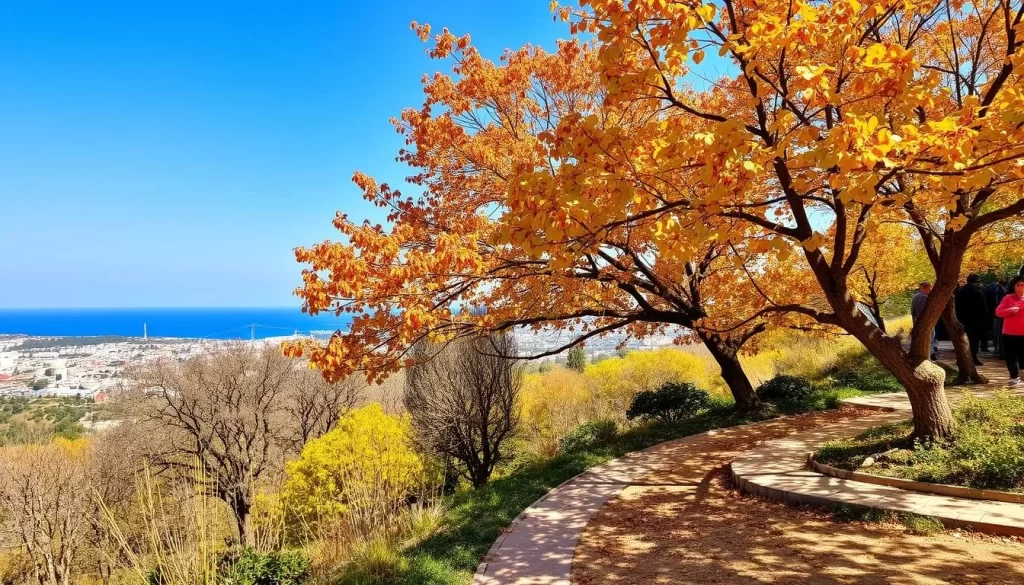
Experience the best of Tunisia during autumn, with its mild climate, fewer crowds, and rich cultural heritage on full display. As the summer heat subsides, the country transforms into an ideal destination for travelers seeking a mix of relaxation and cultural immersion.
Mild Temperatures and Minimal Rainfall
Autumn brings comfortable temperatures to Tunisia, making it an excellent time to explore the country’s outdoor attractions without the sweltering heat of summer. With minimal rainfall, you can enjoy Tunisia’s beautiful landscapes and historical sites in pleasant weather conditions.
Beaches Without the Crowds
The autumn season allows you to enjoy Tunisia’s stunning beaches without the crowds that are typical during the peak summer months. It’s an ideal time for a peaceful retreat or a relaxing vacation by the Mediterranean Sea.
Autumn Cultural Experiences
Autumn in Tunisia is harvest season, particularly for dates and olives, offering a unique opportunity to experience the country’s agricultural traditions and festivals. You can participate in local festivals, sample freshly produced foods, and witness traditional processing methods, gaining a deeper insight into Tunisian culture.
Additionally, cultural venues in cities like Tunis, Sousse, and Sfax begin their new seasons of performances, exhibitions, and events after the summer lull, enriching your cultural experience. The pleasant autumn weather also makes it an excellent time for cooking classes and culinary tours, as markets overflow with fresh seasonal produce and traditional autumn specialties.
Winter Travel: November to March

You can enjoy a variety of activities in Tunisia during the winter months. The cooler weather makes it an ideal time to visit this beautiful country.
Weather Expectations and Packing Tips
During winter, Tunisia’s weather is generally mild, making it perfect for outdoor activities. Daytime temperatures are comfortable, while nights can be cool, especially in the desert regions.
When packing for your travel to Tunisia in winter, include layers for varying temperatures, as well as waterproof gear for occasional rain showers.
Off-Season Benefits: Prices and Accessibility
One of the significant advantages of visiting Tunisia during the winter is the lower prices for accommodations and tourist attractions. You can enjoy a more relaxed experience without the crowds.
Many tourist attractions and facilities remain accessible during the winter months, making it easier to explore the country’s rich history and culture.
Winter Activities and Attractions
Beaches in southern Tunisia, such as those in Djerba and Zarzis, remain pleasant during winter, with temperatures often suitable for sunbathing.
Indoor cultural attractions like the Bardo Museum in Tunis offer enriching experiences, while traditional hammams provide a warm and relaxing cultural experience.
The cooler weather also makes it an ideal time for exploring the Sahara desert, enjoying camel rides, and experiencing the unique landscapes Tunisia has to offer.
Summer Heat: July to August
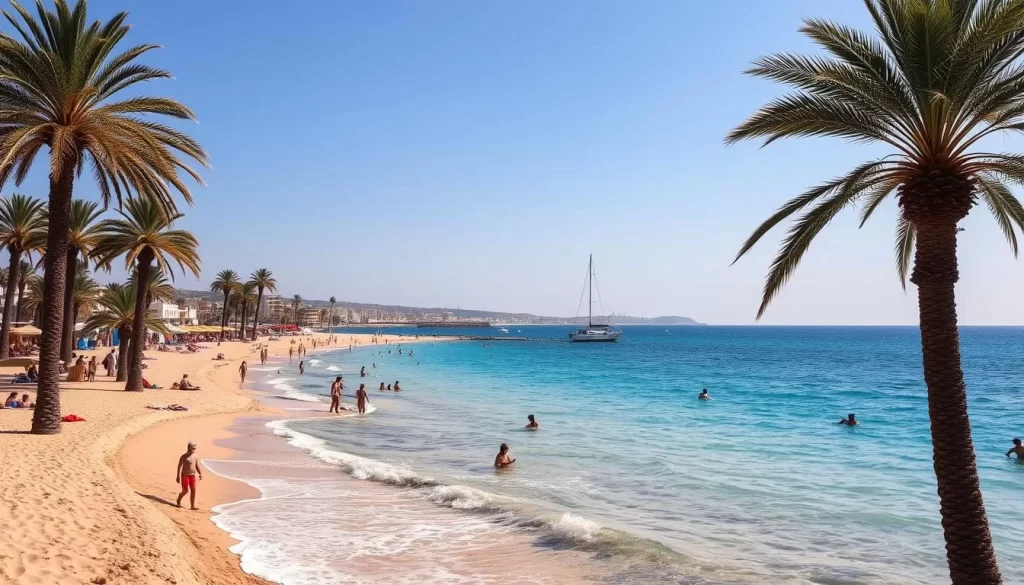
If you’re planning a summer holiday in Tunisia, be prepared for the heat of July and August. These are the hottest months, with temperatures often soaring, especially in the inland areas. However, the Mediterranean coastline offers a cooler respite, making it an ideal time for beachgoers and water sports enthusiasts.
Navigating the Hottest Months
During the peak summer months, the heat can be intense, particularly in the desert regions of southern Tunisia. To make the most of your trip, consider visiting the coastal areas, where the sea breeze provides some relief. Popular destinations like Hammamet, Sousse, and Djerba are bustling with tourists and locals alike, enjoying the beaches and water activities.
Coastal Escapes and Water Activities
The coastal regions of Tunisia become a haven during the summer heat. From Tabarka in the north to Djerba in the south, the beaches offer cooling sea breezes and refreshing waters. Water activities are at their peak, with options including jet skiing, parasailing, snorkeling, and diving in the clear Mediterranean waters. Boat excursions are also popular, providing access to secluded beaches and coves.
Tunisia: Best Months for a Weather-Savvy Trip by Region
Tunisia’s diverse regions offer a range of climates, making it essential to plan your trip according to the best time to visit each area. The country’s geography, which includes coastal regions, mountains, and desert landscapes, contributes to varied weather patterns across different parts of Tunisia.
Northern Tunisia: Tunis and Carthage
Northern Tunisia, including Tunis and Carthage, experiences a Mediterranean climate with mild winters and warm summers. The best time to visit this region is during spring (April-May) and autumn (September-October), when temperatures are pleasant, ranging from 15°C to 25°C (59°F-77°F). These periods are ideal for exploring historical sites and enjoying the local culture without the peak season crowds.
Coastal Regions: Hammamet, Sousse, and Monastir
The coastal regions of Hammamet, Sousse, and Monastir are popular for their beautiful beaches and tourist infrastructure. The summer months (June-August) are peak season here, with warm weather perfect for beach activities. However, for a more relaxed experience, consider visiting during the shoulder season (April-May or September-October), when the weather is still pleasant and the crowds are smaller.
Southern Tunisia and the Sahara
Southern Tunisia and the Sahara Desert have a distinctly different climate, characterized by extreme heat during the summer months (June-August), with temperatures often exceeding 45°C (113°F). The best time to visit the Sahara is during winter (November-March), when daytime temperatures are pleasant, ranging from 15°C to 25°C (59°F-77°F), making it ideal for desert explorations, camel treks, and visits to Berber villages. However, be prepared for cold nights, as temperatures can drop below 5°C (41°F).
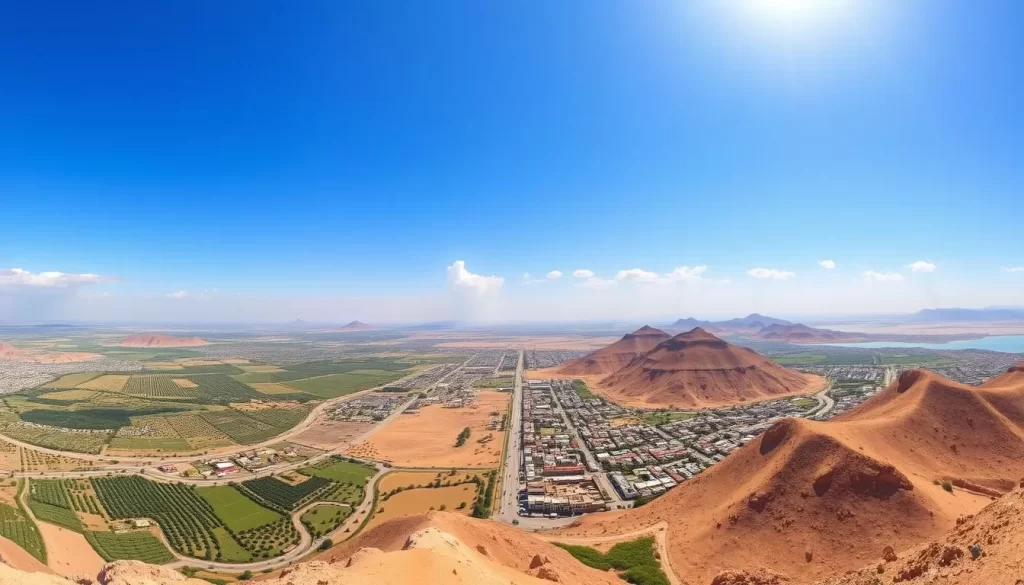
Understanding these regional variations in climate can help you plan a more enjoyable and weather-savvy trip to Tunisia, ensuring that you make the most of your time exploring this fascinating country.
Cultural Festivals and Events Calendar

Tunisia’s cultural calendar is filled with vibrant festivals and events that showcase the country’s rich heritage. Throughout the year, you can experience a mix of cultural traditions that bring people together.
Spring and Summer Celebrations
During the spring and summer months, Tunisia hosts various cultural events that celebrate its rich heritage. You can enjoy traditional music, dance performances, and local cuisine, immersing yourself in the country’s culture.
Fall and Winter Cultural Events
In the fall and winter, Tunisia features events like the Carthage Film Festival, showcasing films from Africa and the Arab world. The Date Festival in Tozeur celebrates the date harvest with cultural performances and traditional food, offering a unique experience. You can also enjoy the Olive Festival, which highlights Tunisia’s olive oil production.
These festivals and events provide a fascinating glimpse into Tunisia’s cultural landscape, making your visit a memorable one throughout the year.
Conclusion
The best time to visit Tunisia is a question that depends on what you’re looking for in your travel experience. For a balanced experience with pleasant weather across most of the country, spring (April-June) and autumn (September-October) are ideal.
These shoulder seasons offer comfortable temperatures, minimal rainfall, and fewer crowds than the peak summer months. Each season in Tunisia presents unique advantages. You can explore the southern desert regions and enjoy cultural experiences without the heat in winter, enjoy beach activities in summer, or experience a perfect mix of warm seas and moderate temperatures in autumn.
By aligning your visit with Tunisia’s rich calendar of cultural festivals, you can add another dimension to your travel experience. With its rich history, diverse landscapes, and warm hospitality, Tunisia ensures a memorable North African adventure, regardless of when you choose to visit.
The above is subject to change.
Check back often to TRAVEL.COM for the latest travel tips and deals.



